Built in 1848, Cape Otway Lighthouse was so isolated in the early years that the lighthouse keeper only found out about the Gold Rush when his annual delivery of supplies including newspapers arrived
My experience at the lighthouse
I really wish I’d done my historical research on Cape Otway Lighthouse before I actually visited the place. It would have given me so many stories to ponder on as I walked around the complex, and would have meant I’d have made time to visit places like the Cape Otway cemetery, which will have to wait now till another visit to Victoria’s most southerly lighthouse.
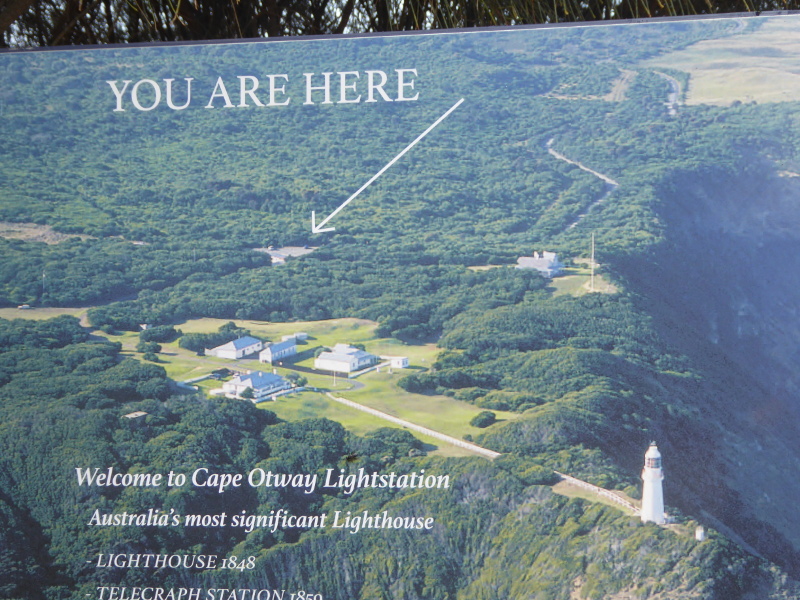
The lighthouse stands about 10kms south of the Great Ocean Road, and to get to it you need to drive through the Otway Forest. That was hard enough on a blustery Sunday in February 2020, with trees down and blocking half the road, and other debris likely at any moment to drift into the pathway of the car.
The gum trees here are extraordinarily beautiful, though, which made it all the more poignant when I was told by the guide at the lighthouse that these are mere saplings compared to the trees the first settlers would have had to find a way through in the 1840s. Reports I found on Trove later suggested tree trunks wide enough to drive a coach and horse through. So this was an incredibly inaccessible place when the lighthouse was built in 1848.
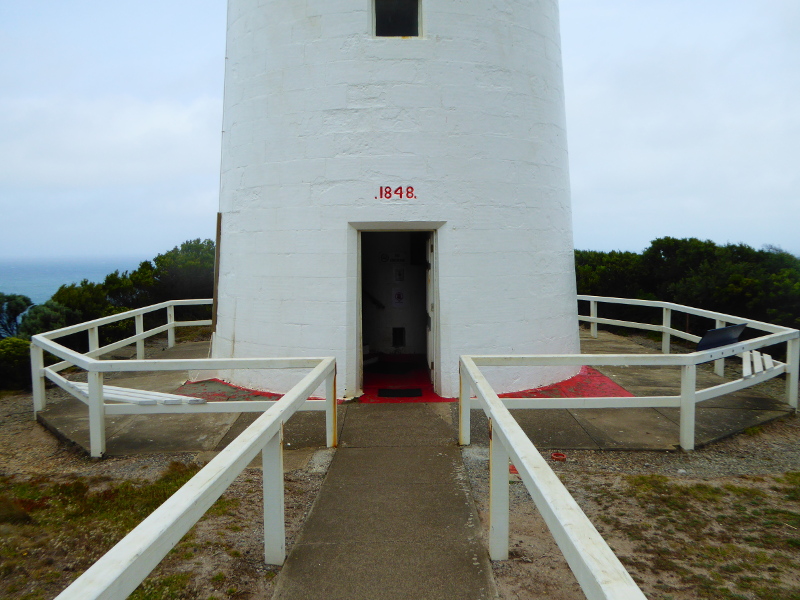
From the entrance to the lighthouse complex (where you pay your fee to visit, though I believe there is an after-hours walk you can do without paying, too), you pass a handful of white weatherboard buildings which were the former Telegraph Office and accommodation for the various lighthouse keepers and their families.
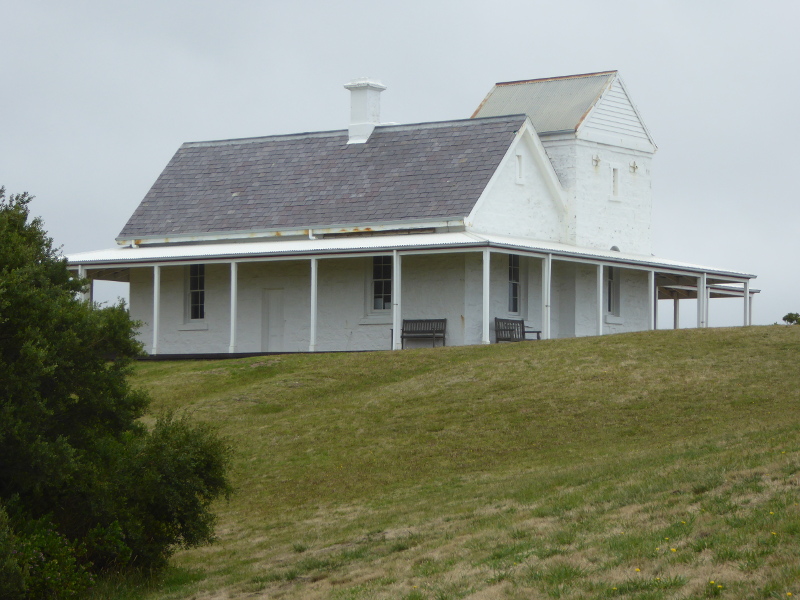
One of those buildings is now a café, and very welcome that was, too, as I just had time for a quick sandwich and coffee before making the history talk at 2pm.
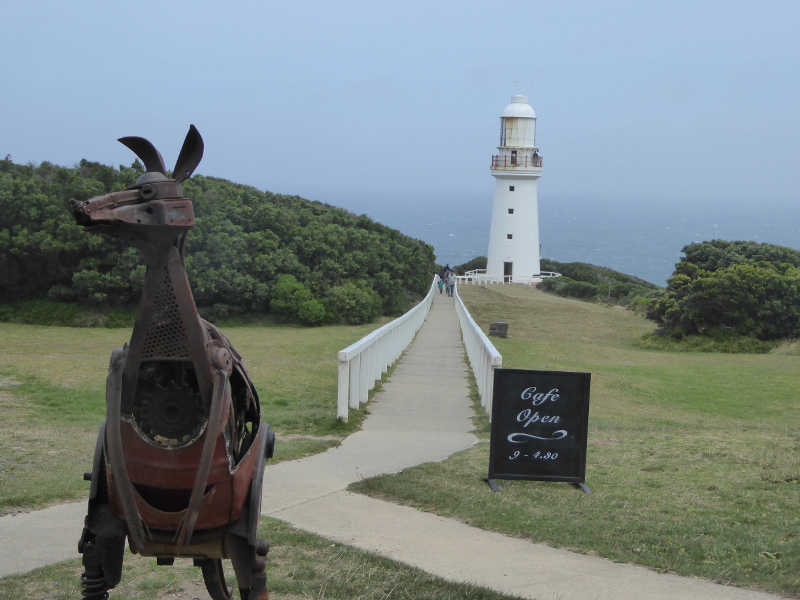
I was amazed to be the only taker for David’s talk, though that actually made for a really fascinating conversation with a man who knows his stuff on Cape Otway, and told a good tale to keep this story-writer interested. I’d highly recommend the history talks, which are not dry and factual at all, but are focused on telling stories, which for me is what history is all about.
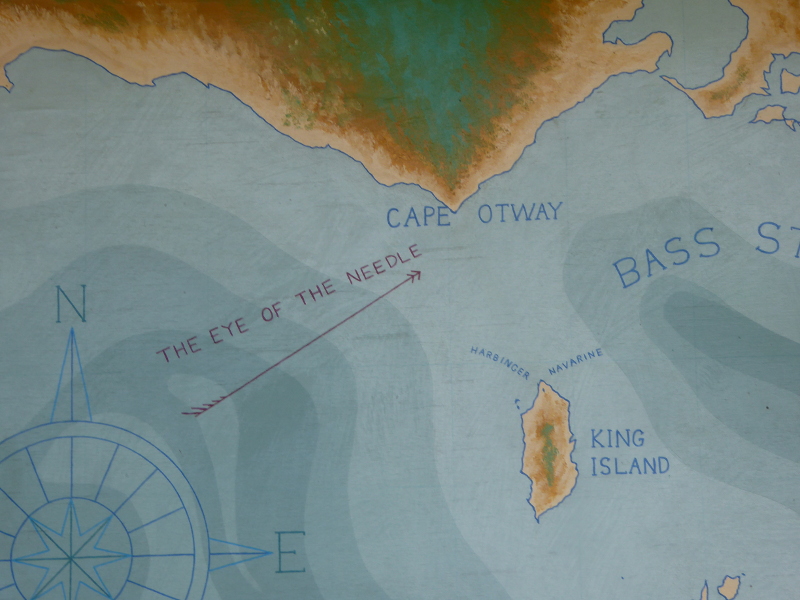
David taught me about how Cape Otway light was often the first sign of life in Australia for 90% of migrants arriving in Australia after weeks at sea, and we discussed the whole lost art of navigating using old instruments like the sextant (how I’d love to do a course and learn how they work); how a 90km gap between King’s Island and Port Phillip Heads might sound a long way but take off 15kms of reefs on either side, and add in gale force winds or pea-soup fogs, and that 90kms quickly becomes a true ‘eye of the needle’.
David also put me right on something I had wrongly imagined from a previous Victorian lighthouse visit: when we speak of the light being brought over ‘flat-pack’ style from Chase Brothers in England, this actually refers of course only to the lanterns, lights and windows at the top of the lighthouse.
The stone walls use local material, and Cape Otway is no exception, with the local sandstone bearing up extremely well after over 170 years now.
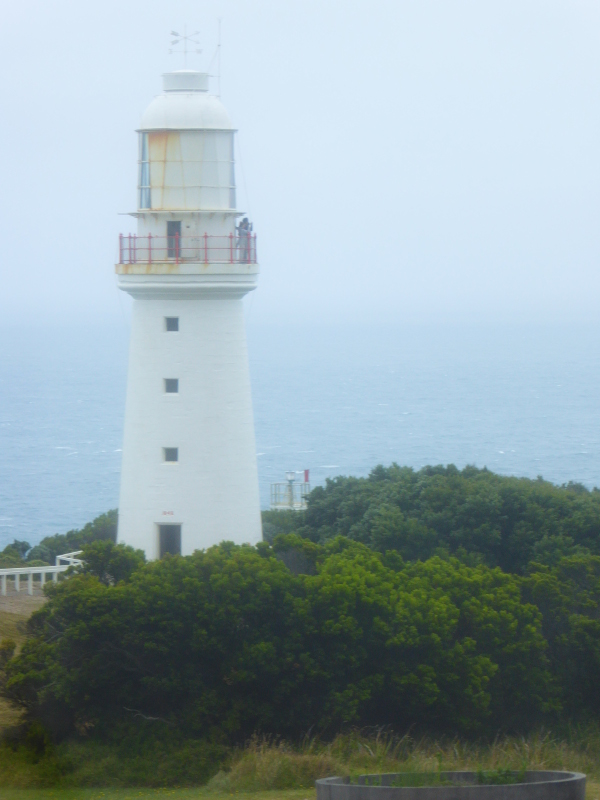
I also enjoyed hearing David’s take on family life at the lighthouse. He recommended a visit to the cemetery to see the graves not only of family members who had lived here, but also some of the bodies recovered after shipwrecks near the lighthouse.
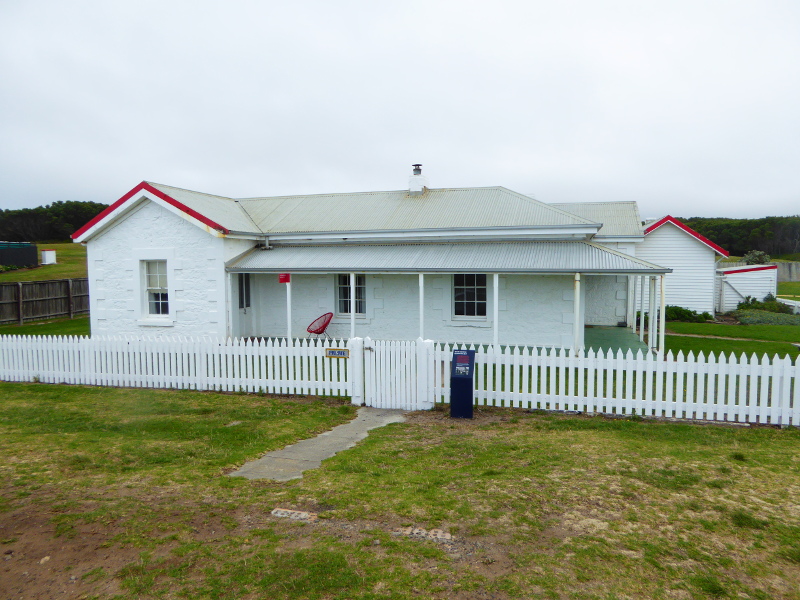
And I liked the way he emphasised the lighthouse keeper’s wife as vital to keep everyone on an even keel at the lighthouse. He was sceptical about how easy it might have been to work under Keeper Ford for those 30 years 1849-79, but reckoned Mary his wife must have been an extraordinary character, as confirmed by some of the stories that came up in Trove, when the keepers’ cottages would suddenly have to become emergency accommodation for shipwreck survivors or play host to visiting officials and dignitaries.
Given the early Trove stories I found on the keeper salaries, it was interesting to hear David talk about the strict hierarchy among the families housed on the complex, with the Telegraph Office being actually the highest paid by far, which led to prickly relations at times with the chief keeper.
This is where I wish I’d done my research before getting to Cape Otway, because I’d love to have chatted with David about the snobby captain who complained at being forced to eat with ordinary sailors after his ship ran aground, or even in deed have asked about the mysterious case of the original keeper in 1848….
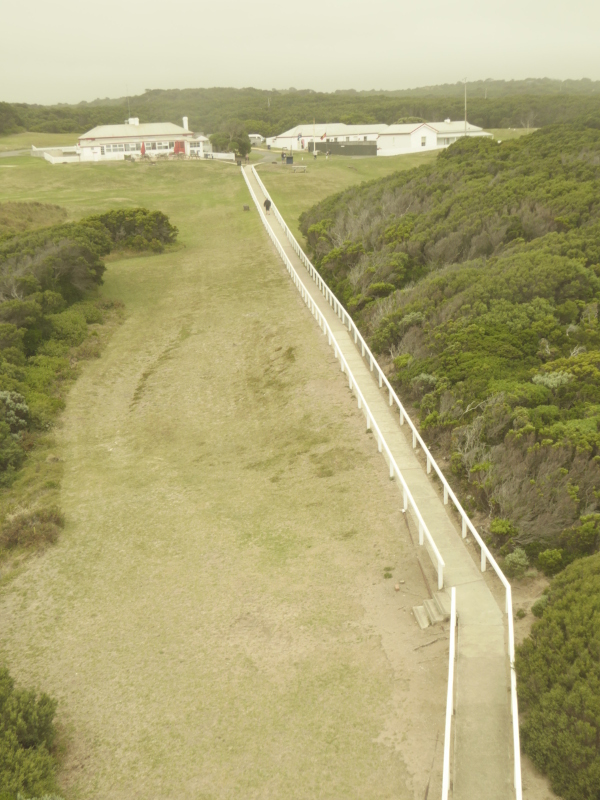
From the history talk, I walked down the long narrow pathway to the lighthouse itself, reflecting on how this might not be a precarious walk as in some lighthouses I have seen over the years, but a long enough distance to get yourself pretty drenched if you had to do this in a hurry in driving rain.
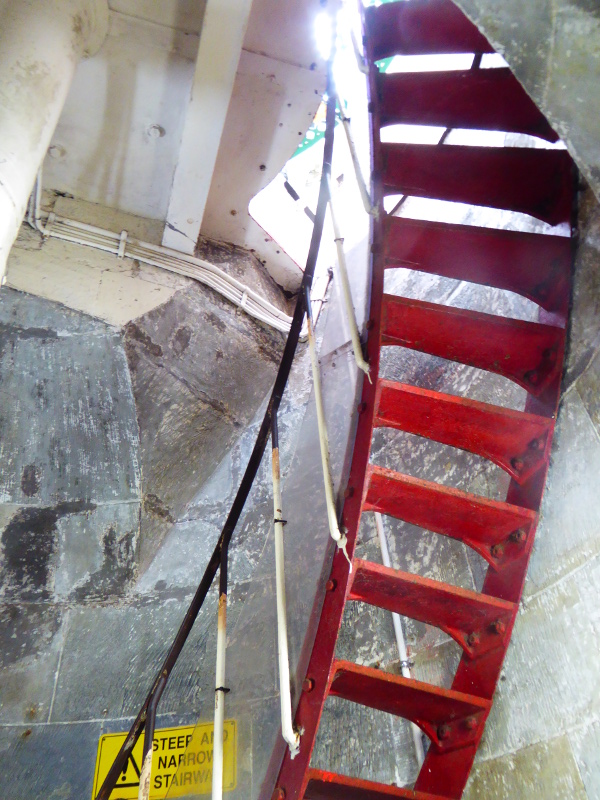
Inside the lighthouse, there are 18 or so iron stairs to climb, which must be pretty well what was there right at the start all those years ago, and then 60 stone steps up to the lantern room.

Up there was Sue, who was due to give the 4pm history talk. She warned me not to risk my lovely new Akubra hat out on the balcony, and although the blurb reckons my hat will stay on in most winds, the gale blowing by now up there on the balcony of the lighthouse made me rather glad to heed her advice.
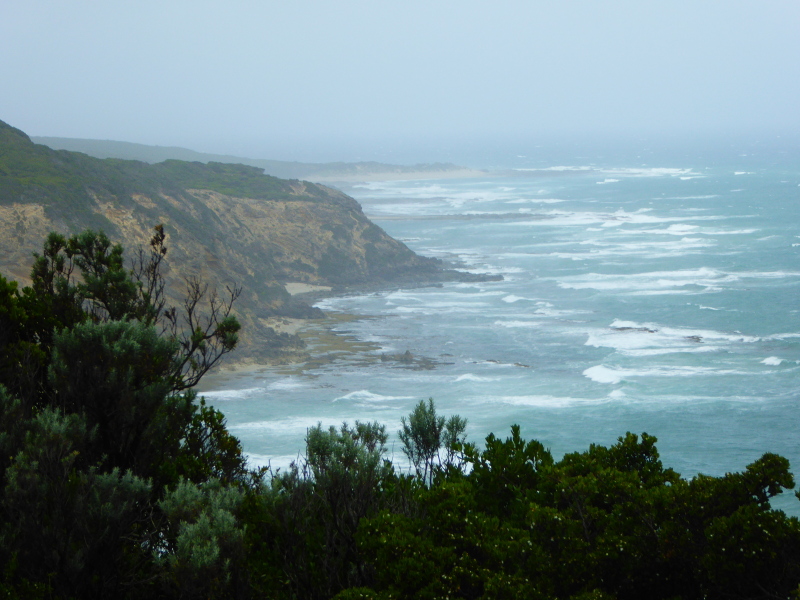
This was a blowy summer’s day and the sea looked treacherous out there.
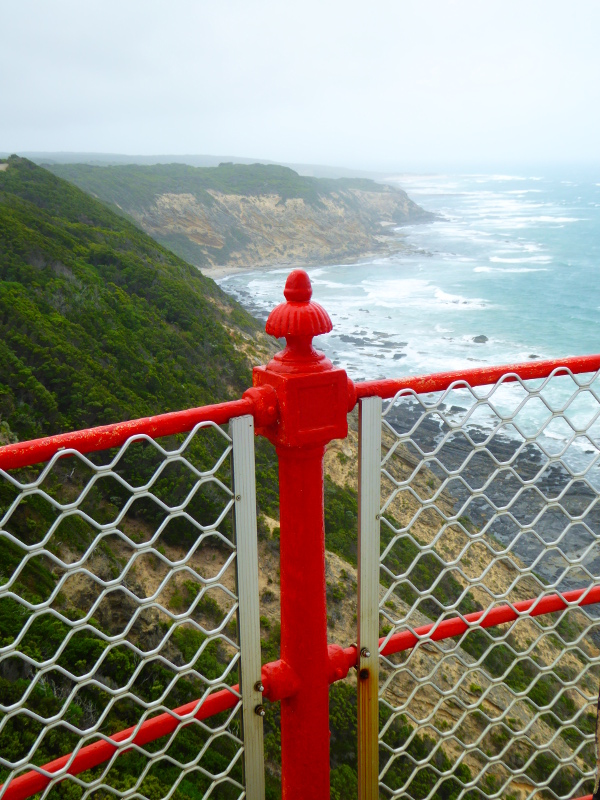
I just about managed to walk right round the balcony, but I was holding on for grim life as I did so, so it’s hard to imagine how tough that would be in a night-time winter’s storm.
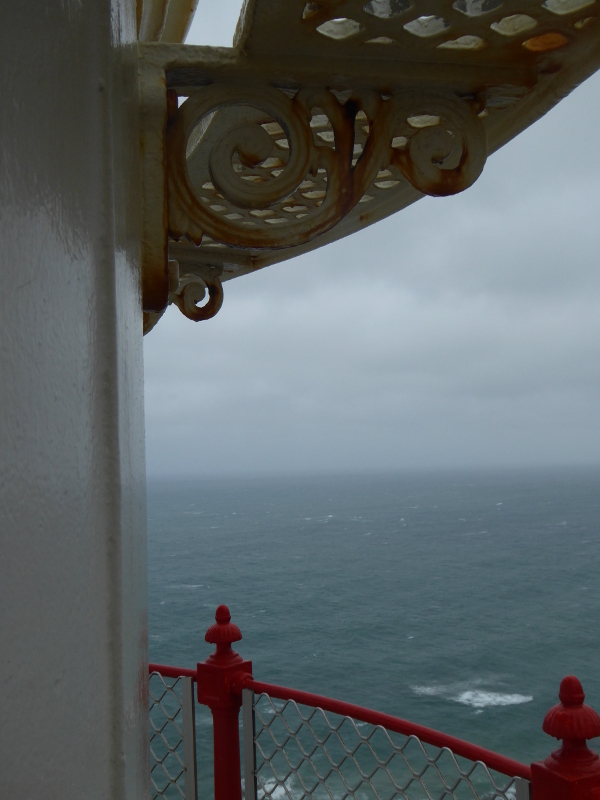
There is a platform even higher up, but I’m glad we aren’t even allowed to try getting there these days.
I wondered how often the relatively thin window panes had been smashed over the years (I know that black swans did fly through in one early incident in the 19th century).

But I also noticed that unlike in some lighthouses, the windows marking different stages on your way up are all lined up facing AWAY from the ocean.
As, of course, is the door into the lighthouse itself.
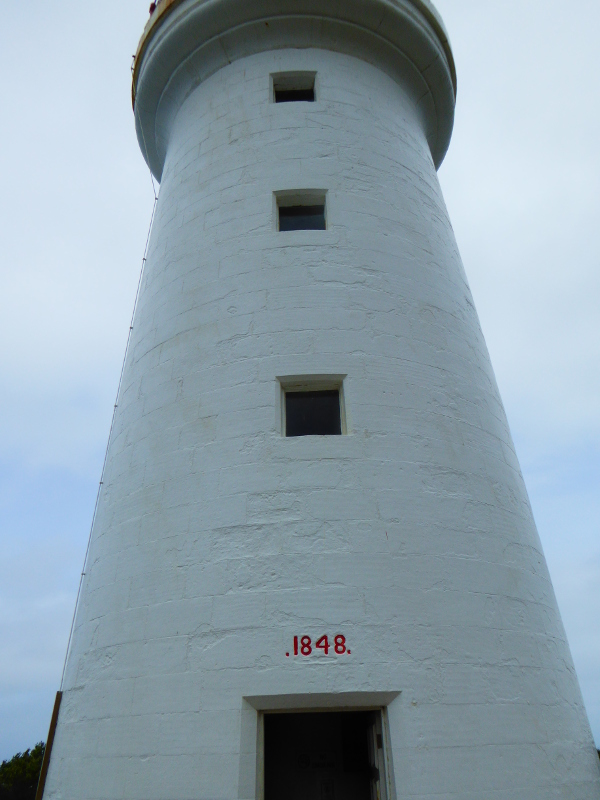
Back up that pathway towards the café and former keepers’ cottages, there is the anchor of one of the more famous shipwrecks off Cape Otway, from the Eric the Red in 1880. Given what I found out later about that particular incident (from Trove), I’m intrigued to know how they even retrieved the anchor at all, and when?
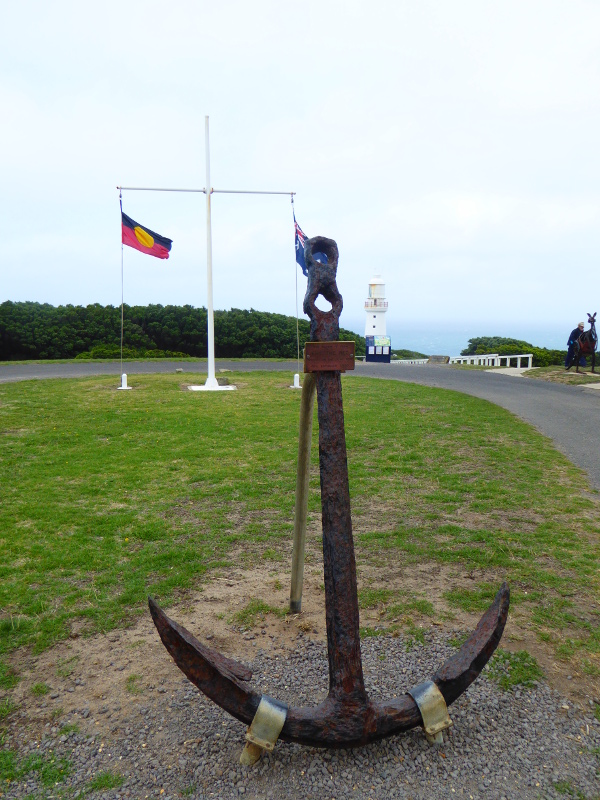
I had a similar take on the shipwrecked bow of the ‘Cape Otway’ back near the entrance to the complex. Is that just a sculpture, with Cape Otway on the hull because that’s where we are, or did it actually come from the steam vessel that served lighthouses around Australia in the 1930s and was called ‘Cape Otway’??
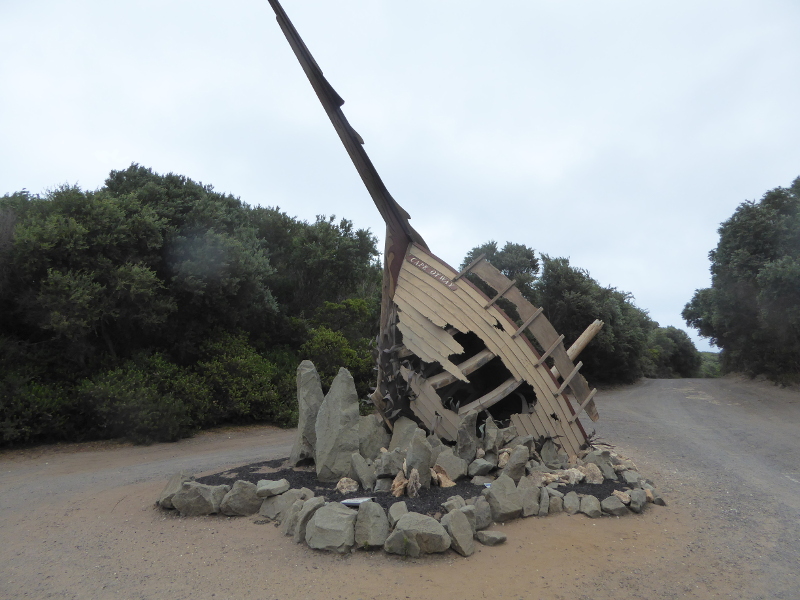
So Cape Otway feels like a Vintage Victoria post only half done. On a future visit, I’ll be going to the cemetery; I’d like to snoop around a bit on the cliff top walks near the lighthouse (though I probably wont be trying to find the caves which are apparently deep into the cliff itself); I’d like to work out exactly where the keepers’ veggie patches were (some 15 minutes walk from the cliff to be sheltered from salty winds, and other a few miles away near one of the rivers); and I’d like to know where the school room was since Cape Otway had the only official school on a lighthouse complex, there were so many kids here at one time.
So there’s definitely good mileage for at least two visits to Cape Otway, and we might even stay the night next time to get a feel for just how quiet it feels here at night, unless the winds are howling, I assume…
Practicalities
$19.50 entrance (though the complex has been closed through the COVID-19 pandemic) – entrance fee gives access to lighthouse and to walk around the whole complex. You can get sightings of the lighthouse from the pathways around, though, if you can’t afford the entrance.
9am – 5pm daily (last ticket 4.30pm)
Cafe on the site very close to the lighthouse.
History and stories
400 died when the Cataraqui went down off King Island in 1845. That led to calls (and action) to have the lighthouse built at Cape Otway – the Cataraqui remains Australia’s worst ever civil maritime disaster.
By July 1847, there were adverts published looking to appoint a lighthouse keeper at 80 quid a year, and an assistant at 45/15/-, though I’m not sure how successful they were in recruiting because by the 1849 estimates, there were requests for 52 more quid for lighthouse keeper salaries. And in 1850 it was announced the keeper salary would be 120 pounds, with about 55 each for two assistants.
The Cape Otway light was finally lit on 29 August 1848, with Lieutenant Lawrence the first keeper. But he only lasted a few months, being dismissed in a rather technical bureaucratic case, where he had chosen to try to fix some of the machinery himself rather than waiting for the proper channels. I’m sure there’s more to that case than meets the eye, and Lt Lawrence wrote to the papers at the time to argue his case, but the matter went quiet and a new keeper was appointed shortly after…
Stores for the lighthouse were delivered once a year in the early days. They were landed at Parker River, a few kilometres away through dense bush. Mind you, a parliamentary debate in 1862 revealed that the staff of the lighthouse were near starvation because of the difficulty getting enough stories in.
On a brighter note, in 1861, the keeper Mr Ford reported he had discovered a thick seam of coal near the track from the river, though it’s not clear from my Trove searches whether anything came of that from a mining point of view, even though Ford was still keeper almost 20 years later.
It’s a measure of how isolated and how densely forested the area was that when a tea ship went aground some 40 miles north west of Cape Otway in 1869, it was the lighthouse that became the refuge for five members of the crew who survived, though another group chose a different route to safety, and four Maori crew members stayed near the vessel. I wonder if any of them told the tale of how they made it from the boat to safety? Or whether the Maori group even survived, because a search party sent out months later found no trace.
Another indication that Cape Otway was pretty isolated in the 1850s was the fact – learnt through newspaper correspondence many years later – that Keeper Ford only found out about the Gold Rush in Victoria via the London newspapers he had delivered in his annual shipments. I guess inland news didn’t get to the coast that easily back then, at least until the Telegraph Office was built in 1860.
September 1880 saw the wrecking of the Eric the Red, which had come from New York and was heading to Melbourne. This is the ship whose anchor stands now near the café on the Cape Otway lighthouse grounds. Its cargo contained exhibits for the Melbourne Expo of 1880, the first time that had been held in the southern hemisphere. The captain was deceived by the haze and mistakenly thought he was still six miles off the reef when the boat went aground.
In 1884 the then lighthouse keeper Mr Cordell found a message in a bottle at the base of the lighthouse. But this was no casual passenger leaving a love note or school child seeing how far the bottle would carry. No, this was potentially an early case of foreign espionage. A German naval officer had placed the message in the bottle with exact compass references and date of deposit, and instructions to whoever found it to write the same on the reverse side when it was found, and to return it to the German Admiralty in Berlin.
A few months later, 30m of canvas and rubber belting was found on the rocks near the lighthouse, all needing to be logged by the keeper. He must have been wondering what would wash up next…
The 1890s saw a series of bushfires, which affected life at Cape Otway Lighthouse. One fire cut the telegraph line to Lorne; another caused a smoke haze which made it impossible to watch ships at sea (the article I read didn’t say whether ships could still see the Otway Light, but the fact that 900 rockets were fired from the lighthouse in 4 days one year suggests not). One fire came to within 50m of a gunpowder store so all women and children living at the Lighthouse were sent down below the cliffs for safety. In 1898 all fences and grass around the lighthouse burnt away.
Cape Otway Lighthouse received delivery of supplies just twice a year from 1859, but the boats making the journey to Blanket Bay, some 10kms from the lighthouse, were themselves at risk in bad weather. Three men drowned when the delivery boat capsized in 1896. One of these, a chief officer aged 32, was heard to scream ‘pitifully’ for help as he clung to rocks, but nobody could get to him before he was washed away. An interesting note a few weeks later in one of the local papers hailed Joe ‘The Hermit’, who lived in poverty, with only one hand, but did everything he could to help the survivors; it also spoke of how much the officer who died was loved by all: “crew members cried like babies when they saw he could not be saved”; but another officer was derided for his ungrateful arrogance on being rescued, and his apparent complaints at being asked to sit and eat at the lighthouse with common sailors – ah, class and the English huh? – even in a shipwreck…
The cemetery near the lighthouse looks like it is an interesting place, although a sad place too, as so many of the bodies buried there must have resulted from wrecks near the cliffs here. In 1915, keeper Porteous died suddenly at the lighthouse – I wonder if he is buried there?
I really liked Yvonne Isobel Backhouse’s 1909 account of a trip to Cape Otway Lighthouse. She had an intrepid 30 mile trip from her home to reach the Cape, though. The Aire River was 4m deep so impossible to cross, but they discovered that that was due to a new sandbank on the coast which meant the river was dammed temporarily after a storm had moved tons of sand to its mouth. They simply walked across the sandbank to get to the Cape! Her description of the 60 step climb up the iron staircase could have been written in 2009 rather than 1909, so little had changed there. The light can be seen as far away as Kings Island, she reckoned – Is that still true today? And she was moved by the gravestones in the cemetery, with names she had read about from shipwrecks in her lifetime. Makes me wish I’d had time to visit the cemetery myself.
I often wonder how families at lighthouses like this one coped when someone fell ill and needed medical attention. Even as late as 1927, they depended on the bush-nursing clinic at Apollo Bay. A woman’s life was saved by a Sister Murray, who rode alone through the forest, falling off her horse on the way, and ending up on the sick bed herself.
But more serious was the whooping cough outbreak in 1935, when a doctor was despatched from Colac. Six of the 13 kids in the community were affected, with Audrey Rixon, aged 6, the most ill. The story made the news across Australia, and led to further information pieces on the only lighthouse school in the country.
But snippets over the years show a defiance among the keepers and their families over perceptions of life at Cape Otway. At Christmas 1933, The Herald reported on the four families sitting down to plum pudding like the rest of Australia, after Santa’s visit to the kids; and another roving reporter in the late 20s who hiked to Cape Otway was regaled with scones and jam, only to be disappointed to be told he couldn’t climb the iron staircase due to the wet weather making the steps slippery.
One later story that caught my eye on Trove dates from 1951 when James Harper arrived from Scotland with his wife to join the team at Cape Otway. His wife’s great great grandfather had lit the first lighthouse on Scotland’s Rhinns of Islay – that’s still on my to-do list for Scottish lighthouses…
But the final shipwreck I read about on Trove dated from 1954 when a small fishing boat hit a reef near the lighthouse and sank in three minutes. The three men on board survived by holding onto empty oil drums they threw overboard before jumping in themselves. One lay on the beach for an hour after getting ashore, Don Denning making it to the lighthouse to call for help at about 4am. The other two were found the next morning. Maxwell Edwards and Roy Mitchell would be in their 80s now – can they remember the incident and being found like that?
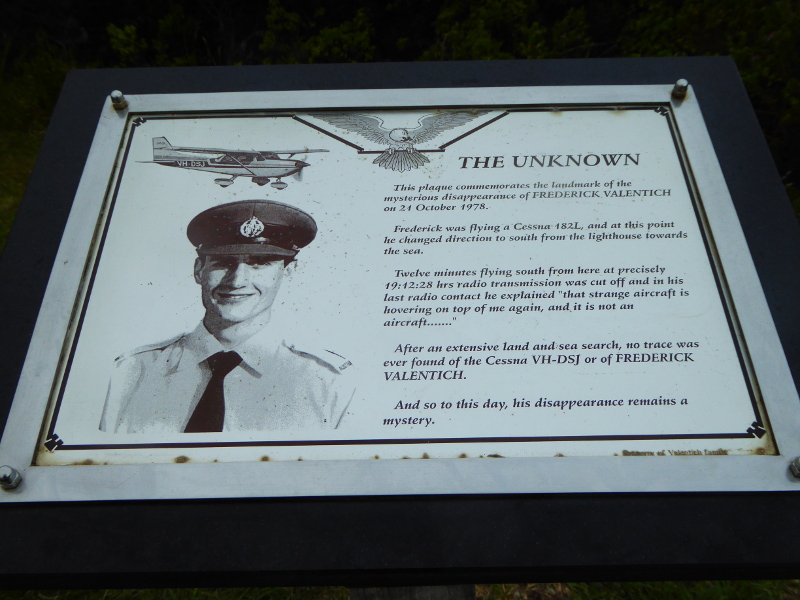
The most recent mystery – and one which has its own information board near the lighthouse even today – dates from 1978, when a pilot reported an unidentified aircraft below him and then hovering above. No military aircraft were in the vicinity, so other than speculation that this was a UFO, the only other theory seems to be that the pilot got disoriented and was flying upside down, spotting the lights of Cape Otway lighthouse ‘above’ him. The plane crashed, though, and the pilot’s body was never recovered.
What are your experiences at Cape Otway Lighthouse?
Has anybody been to the Cape Otway lighthouse and have a top story to share? Or any news story that I might have missed from the 1960s forwards?
Has anybody been to the Lighthouse cemetery, and if so, what’s your favourite headstone?
Does anyone know of any offspring or relatives of James Harper, the 1950s keeper from Scotland? I’d love to interview them, if so.
Does anybody know if Audrey Rixon is still alive today (maybe with a married name)? Does she remember her whooping cough scare?
Or what about Maxwell Edwards or Roy Mitchell? And can they remember their incident with the oil drums in 1954?
Other links and writings on the Cape Otway Lighthouse
Cape Otway Lighthouse has its own website.
There is of course an entry for Cape Otway on the Lighthouses of Australia website.
The Our 3 Kids v the World blog has a nice description of how it is to take a bunch of kids to Cape Otway.
The Mum on the Move website has a similar take on visiting as a family.
Lots of other lighthouses here on this blog – and they had better weather than me on their visit to Cape Otway
The Adventures From Where You Want to Be blog visited on a foggy day in 2017.
I liked this ABC story on Michael Brack who lived at Cape Otway, and at other lighthouses in Victoria.
For someone who doesn’t really like lighthouses, this Thinkoholic guy got well into the Cape Otway lantern room.
Lots of bloggers have visited Cape Otway Lighthouse, including in 2017 Talgache Revitalized.
The Experimental Ghost bloggers were biking along Great Ocean Road and made a blog entry on the lighthouse, even if they were annoyed with the cost of entry.
I liked this Hiking Fiasco blog post, partly because the walk from Blanket Bay was what deliveries of goods for the lighthouse had to do in the early days, so it was quite nice to see how tough it was in recent years and think how it must have been in the 19th century.
Cup of coffee or tea before or after the talks?
The cafe in the old keeper’s accommodation does a lovely looking cream tea (always called ‘Devonshire Tea’ by Australians, for some reason). I was there at lunch time so needed something savoury and the coffee was decent enough, but part of me wished I’d arrived a little later, in time for tea.


Thank you so very much for the mention, I appreciate it. Loved reading your thorough experience of Cape Otway Lighthouse, makes me want to return and dive deeper into the history and landscape around here <3
I’d like to know what the light signature was for the lighthouse in 1848. Presuming it was different when was its current signature assigned?